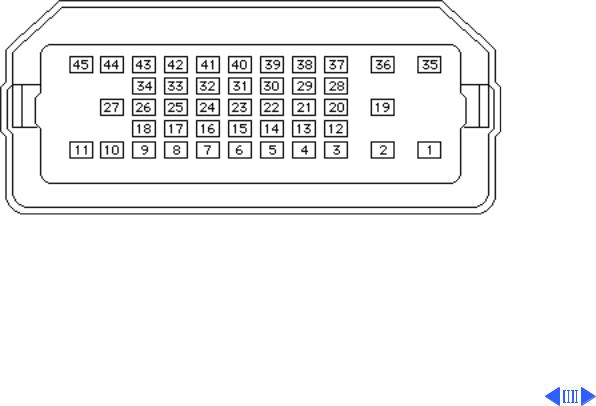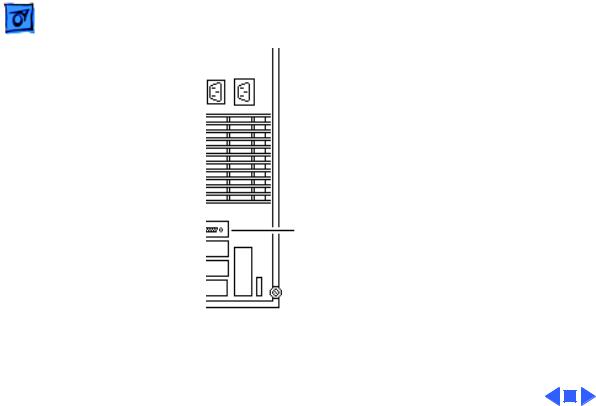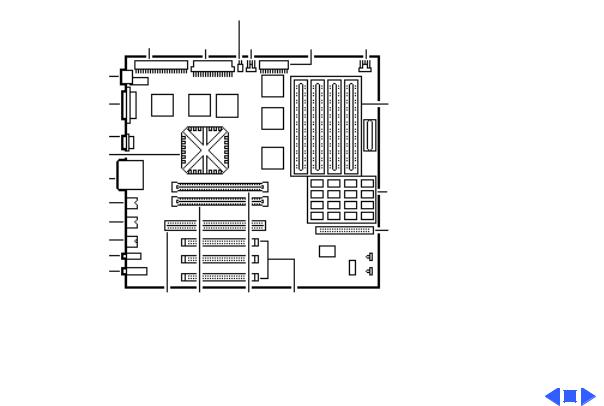Apple Macintosh Powermac Performa WS8150 Service Manual

K Service Source
Power Macintosh 8100/
WS 8150
Power Macintosh 8100/80 and 8100/80AV, Power
Macintosh 8100/100 and 8100/100AV, Power
Macintosh 8100/110, Workgroup Server 8150,
Workgroup Server 8150/110

K Service Source
Basics
Power Macintosh 8100/WS 8150

Basics |
Power Macintosh System Overview - 1 |
|
|
|
|
Power Macintosh System Overview
PowerPC microprocessors are a family of processors built on reduced instruction-set computing (RISC) technology. RISC processors streamline the internal workings of computers. Whereas traditional (complex instruction-set computing, or CISC) processors contain a wide variety of instructions to handle many different tasks, RISC processors contain only those instructions that are used most often. When a complex instruction is needed, a RISC processor builds it from a combination of basic instructions.
RISC processors are designed to execute these basic instructions extremely quickly. The performance gains achieved by speeding up the most-used instructions more than compensate for the time spent creating less-used instructions.

Basics |
Power Macintosh System Overview - 2 |
|
|
|
|
|
Previously, RISC technology had been used only in high-end |
|
|
workstations and commercial database servers. With the |
|
|
introduction of Macintosh PowerPC computers, Apple |
|
|
succeeded in bringing RISC technology to personal |
|
|
computing. |
|
Key Points
Three key points to remember about a PowerPC processorbased Macintosh system: It's a Macintosh; it's compatible; it offers tremendous performance.
Apple's PowerPC computers feature the same user interface as their 680x0-based predecessors. Users can mix RISCbased and 680x0-based Macintosh systems on the same network and exchange files and disks between them. In addition, users can run both 680x0 and native PowerPC applications on the same Power Macintosh system simultaneously.

Basics |
Power Macintosh System Overview - 3 |
|
|
|
|
|
Compatibility is not limited just to applications. INITs, |
|
|
CDEVs, drivers, and other Macintosh utility software also |
|
|
work on PowerPC processor-based Macintosh systems. So do |
|
|
AppleTalk devices (such as printers), SCSI devices (such as |
|
|
hard drives and scanners), ADB devices (such as mice, |
|
|
trackballs, and keyboards), and other Macintosh cards and |
|
|
peripherals. |
|
|
The primary operating system for PowerPC processor- |
|
|
based Macintosh computers is System 7. The operating |
|
|
system has been optimized for the highest performance on |
|
|
the PowerPC processor. This optimization of System 7 |
|
|
benefits applications written for 680x0 systems as well as |
|
|
those developed specifically for PowerPC processor-based |
|
|
systems. |
|
|
And while PowerPC-based Macintosh systems running |
|
|
native applications offer two to four times the performance |
|

Basics |
Power Macintosh System Overview - 4 |
|
|
|
|
|
of the fastest 68040and 80486-based personal |
|
|
computers, the real promise of PowerPC technology is that |
|
|
it enables Apple and other developers to deliver new |
|
|
software capabilities on Macintosh systems that were |
|
|
previously available only on high-end workstations. |
|
Troubleshooting Tips
When troubleshooting Power Macintosh systems, keep in mind the following:
1 If a Power Macintosh system does not power up, you should first attempt to reset the logic board. Instructions are provided in the Additional Procedures chapter.
2 With Power Macintosh computers, you must install noncomposite RAM SIMMs only, and the RAM SIMMs must be installed in like pairs (that is, the same size and speed). Additional troubleshooting information is

Basics |
Power Macintosh System Overview - 5 |
|
|
|
|
provided in the Symptom Charts section of the Troubleshooting chapter under the “System” topic heading.
3If a Power Macintosh system has bad RAM SIMMs installed, you will not hear death chimes. Instead, a dialog box will appear alerting you to the fact that a bad RAM SIMM has been detected. Additional troubleshooting information is provided in the Symptom Charts section of the Troubleshooting chapter under the “System” topic heading.
4If the system hangs shortly after installing a new NuBus card, contact the vendor to verify that the card is compatible with the Power Macintosh system or to see if there is a software upgrade available. If the NuBus card is an Apple manufactured product, refer to the Service Tech Info Library for more information.

Basics |
Power Macintosh System Overview - 6 |
|||
|
|
|
||
|
5 The Power Macintosh AV systems use the same logic |
|||
|
board as the non-AV versions. The only difference is that |
|||
|
the AV versions have the Power Macintosh AV Card |
|||
|
installed in the PDS slot. |
|||
|
The Power Macintosh 7100/66 and 8100/80 systems |
|||
|
must have a video card installed in the PDS slot. The |
|||
|
Power Macintosh 7100/66 system uses the Power |
|||
|
Macintosh 2 MB Video Card and the Power Macintosh |
|||
|
8100/80 system uses the Power Macintosh 4 MB Video |
|||
|
Card. A missing card can result in a system that won't |
|||
|
boot or a system that crashes. |
|||
|
|
|
|
|
|
|
|
|
|

Basics |
HDI-45 Pinouts - 7 |
|
|
|
|
HDI-45 Pinouts
This section includes an illustration of the HDI-45 connector and a table containing the pinout descriptions.
Figure: HDI-45 Connector on the Logic Board

Basics |
HDI-45 Pinouts - 8 |
|||
|
|
|
|
|
|
|
Table: HDI-45 Pinouts |
||
|
|
|
|
|
|
Pin |
Description |
|
|
|
|
|
|
|
|
1 |
Analog audio ground |
|
|
|
|
|
|
|
|
2 |
Audio input shield |
|
|
|
|
|
|
|
|
3 |
Left channel audio input |
|
|
|
|
|
|
|
|
4 |
Right channel audio input |
|
|
|
|
|
|
|
|
5 |
Left channel audio output |
|
|
|
|
|
|
|
|
6 |
Right channel audio output |
|
|
|
|
|
|
|
|
7 |
Reserved |
|
|
|
|
|
|
|
|
8 |
Monitor ID sense line 1 |
|
|
|
|
|
|
|
|
9 |
Monitor ID sense line 2 |
|
|
|
|
|
|
|
|
10 |
Green ground (shield) |
|
|
|
|
|
|
|

Basics |
HDI-45 Pinouts - 9 |
|||
|
|
|
|
|
|
|
|
|
|
|
Pin |
Description |
|
|
|
|
|
|
|
|
11 |
Green video output (75Ω) |
|
|
|
|
|
|
|
|
12 |
Video input power ground |
|
|
|
|
|
|
|
|
13 |
Power for camera +5 V |
|
|
|
|
|
|
|
|
14 |
Reserved |
|
|
|
|
|
|
|
|
15 |
Reserved |
|
|
|
|
|
|
|
|
16 |
Reserved |
|
|
|
|
|
|
|
|
17 |
Reserved |
|
|
|
|
|
|
|
|
18 |
Monitor ID sense line 3 |
|
|
|
|
|
|
|
|
19 |
S-video input shield |
|
|
|
|
|
|
|
|
20 |
S-video input luminance (Y) |
|
|
|
|
|
|
|
|
21 |
S-video input chroma (C) |
|
|
|
|
|
|
|

Basics |
HDI-45 Pinouts - 10 |
|||
|
|
|
|
|
|
|
|
|
|
|
Pin |
Description |
|
|
|
|
|
|
|
|
22 |
Reserved |
|
|
|
|
|
|
|
|
23 |
Reserved |
|
|
|
|
|
|
|
|
24 |
Reserved |
|
|
|
|
|
|
|
|
25 |
Reserved |
|
|
|
|
|
|
|
|
26 |
Red ground (shield) |
|
|
|
|
|
|
|
|
27 |
Red video output (75Ω) |
|
|
|
|
|
|
|
|
28 |
I 2C data signal |
|
|
|
29 |
I 2C clock signal |
|
|
|
30 |
Reserved |
|
|
|
|
|
|
|
|
31 |
Monitor ID |
|
|
|
|
|
|
|
|
32 |
Monitor ID |
|
|
|
|
|
|
|

Basics |
HDI-45 Pinouts - 11 |
|||
|
|
|
|
|
|
|
|
|
|
|
Pin |
Description |
|
|
|
|
|
|
|
|
33 |
Vertical sync signal |
|
|
|
|
|
|
|
|
34 |
Composite sync signal |
|
|
|
|
|
|
|
|
35 |
ADB power +5 V |
|
|
|
|
|
|
|
|
36 |
ADB ground |
|
|
|
|
|
|
|
|
37 |
ADB data |
|
|
|
|
|
|
|
|
38 |
Keyboard switch |
|
|
|
|
|
|
|
|
39 |
Reserved |
|
|
|
|
|
|
|
|
40 |
Reserved |
|
|
|
|
|
|
|
|
41 |
Monitor ID |
|
|
|
|
|
|
|
|
42 |
Horizontal sync signal |
|
|
|
|
|
|
|
|
43 |
Video sync ground |
|
|
|
|
|
|
|

Basics |
HDI-45 Pinouts - 12 |
|||||
|
|
|
|
|
||
|
|
|
|
|||
|
Pin |
Description |
|
|
|
|
|
|
|
|
|||
|
44 |
Blue ground (shield) |
|
|
|
|
|
|
|
|
|||
|
45 |
Blue video output (75Ω) |
|
|
|
|
|
|
|
|
|
|
|
|
|
|
|
|
|
|
|
|
|
|
|
|
|

Basics |
Rear Panel Connectors - 13 |
|
|
|
|
Rear Panel Connectors
The figure on the following page shows a Power Macintosh 8100 computer with a 4 MB Video Card installed. The AV version of the Power Macintosh 8100 would have a Power Macintosh AV Card installed instead of the 4 MB Video Card. In addition to a DB-15 connector, the AV Card includes an S- Video Input and an S-Video Output port.

Basics |
Rear Panel Connectors - 14 |
|
|
|
|
Power-On
SCSI
Ethernet
HDI-45 Video
Printer DB-15
Modem
ADB
Sound Out
Sound In
Power Macintosh 8100 Rear Panel

Basics |
Logic Board Connectors - 15 |
|
|
|
|
Logic Board Connectors
The figure on the following page shows a Power Macintosh 8100/80 logic board.
Caution: It is important to note that the Power Macintosh 8100/100 and 8100/110 Series logic boards have a thermoelectrical cooling device that attaches directly to the microprocessor’s heatsink. You can identify this cooling device by the black and red wires that run to the right of the heatsink and plug into the logic board via a keyed connector. This device is not a serviceable item. Do not unplug this device or you may damage the logic board.

Basics |
- 16 |
|
|
|
|
|
Speaker |
|
|
|
CD-ROM/ |
Power |
CD-ROM Floppy |
|
|
Tape SCSI |
Supply |
Audio |
Drive |
LED |
Power On
SCSI
Ethernet
PowerPC 601 Chip
HDI-45 Video
Printer
Modem
ADB
Sound Out
Sound In
601 ROM L2 Cache NuBus
PDS Slot Slot Slots
DRAM SIMMs
8 MB Soldered
DRAM
Hard Drive
SCSI

Basics |
Apple RAID Software - 17 |
|
|
|
|
Apple RAID Software
Apple RAID (Redundant Array of Independent Disks) software protects data from loss during a disk failure and enhances the speed of data storage and retrieval. It is available for all Power Macintosh Workgroup servers.
Data protection is achieved through disk mirroring, a data storage scheme in which identical data is stored on two different disks. Apple RAID can also be configured for disk striping, a data storage scheme in which successive units of data are transferred to several disks at one time.
If you plan to install the Apple RAID software on an existing Power Macintosh Workgroup Server, or if you are reinitializing an existing Apple RAID drive, keep in the mind the following:

Basics |
Apple RAID Software - 18 |
|
|
|
|
• If you wish to use your server's startup disk for Apple |
||
|
RAID, do not install the Apple RAID program on your |
|
|
startup disk until you have initialized and set up new |
|
|
volumes on that disk. Before you initialize the startup |
|
|
disk, back up all valuable data. |
|
• |
You must reinitialize all disks on which you will use |
|
|
Apple RAID volumes. Initializing with Apple RAID |
|
|
removes all data, so be sure to back up your disks first. |
|
• Apple HD SC Setup does not recognize Apple RAID |
||
|
volumes. If you want to remove or resize volumes on |
|
|
Apple RAID disks, use the Apple RAID program. |
|
• |
The Apple RAID CD contains the facilities to reinstall |
|
|
your system software. However, if you have made any |
|
|
customizations to your system files, such as adding |
|
|
extension files, control panels, or preference files, then |
|

Basics |
Apple RAID Software - 19 |
|||
|
|
|
||
|
back up your system files now. Back them up in such a |
|||
|
way that you can restore your system files separately |
|||
|
from the nonsystem files on your disk. You will later |
|||
|
restore your system files using the backup copy rather |
|||
|
than the System Installer on the RAID CD, so that you |
|||
|
preserve your system customizations. |
|||
|
|
|
|
|
|
|
|
|
|

K Service Source
Specifications
Power Macintosh 8100/WS 8150

Specifications |
Processor - 1 |
|
|
|
|
CPU
8100/80 & 8150
8100/100, 8100/110 & 8150/110
Processor
Built-in MMU and FPU
32K of on-chip cache memory
80, 100 or 110 MHz PowerPC 601 RISC microprocessor Requires system software version 7.1.2 or later Requires system software version 7.5 or later
Note: To run System 7.5 on these systems, you need enabler version 1.1.1 at a minimum. This version of the system software requires Finder version 7.1.5. You can verify the Finder version installed by using the "Get Info" command. Refer to the Tech Info Library for more information.

Specifications |
Memory - 2 |
|
|
|
|
Memory
RAM
8100/80, 8100/100 & 8150
8100/110 & 8150/110
8 MB RAM soldered on logic board, expandable to 264 MB via 8 SIMM sockets on logic board (using pairs of same size, 80 ns or faster, 72-pin noncomposite SIMMs); Optional 16 MB configuration has two 4 MB SIMMs installed
16 MB RAM standard (8 MB soldered on logic board and two 4 MB SIMMs), expandable to 264 MB via 8 SIMM sockets on logic board (using pairs of same size, 80 ns or faster, 72-pin noncomposite SIMMs)
Note: SIMMs must be installed in pairs of the same size. Install noncomposite SIMMS only.

Specifications |
Memory - 3 |
|
|
|
|
VRAM
8100/80, 8100/100, 8100/110, 8150 & 8150/110
8100/80AV & 8100/ 100AV
8150 & 8150/110
ROM
Cache
Clock/Calendar
2 MB of VRAM on video card, expandable to 4 MB using 512K VRAM SIMMs
2 MB of VRAM on Macintosh AV card, including support for NTSC or PAL monitors
None
4 MB installed on ROM SIMM
32K on-chip cache; 256K level 2 cache SIMM CMOS custom chip with long-life lithium battery

|
Specifications |
|
Disk Storage - 4 |
|
|
|
|
|
|
|
|
Disk Storage |
||
Hard Drive |
|
|
|
|
8100/80 |
500 |
MB or 1 GB hard drive |
||
8150 |
500 |
MB, 1 GB, or 2 GB hard drive |
||
8100/100 |
700 |
MB or 1 GB hard drive |
||
8100/110 |
2 GB hard drive |
|||
8150/110 |
1 GB hard drive |
|||
Floppy Drive |
1.4 MB Apple SuperDrive Manual Insert |
|||

|
Specifications |
Disk Storage - 5 |
|||
|
|
|
|
||
CD-ROM Drive |
Internal AppleCD 300 Plus CD-ROM drive optional on some |
||||
|
|
models and standard on other models |
|||
8150/110 |
AppleCD 600 CD-ROM drive standard |
||||
|
|
|
|
|
|
|
|
|
|
|
|

Specifications |
I/O Interfaces - 6 |
|
|
SCSI
Serial
Apple Desktop Bus
Ethernet
I/O Interfaces
One SCSI port; DB-25 connector
Supports maximum of six external devices (five with CD-ROM drive)
Two RS-232/RS-422 LocalTalk/GeoPort serial ports; mini DIN- 9 connectors (backward compatible with mini DIN-8 connectors)
One Apple Desktop Bus (ADB) port; mini-Din-4 connector Maximum power draw 500 mA; maximum of three devices total
One Ethernet port; AAUI-15 connector

|
Specifications |
I/O Interfaces - 7 |
|
|
|
|
|
Expansion Slot |
One processor-direct slot (PDS); 182-pin connector |
||
NuBus |
Three slots support long or short expansion cards; 96-pin Euro- |
||
|
|
DIN connectors |
|
Sound |
16-bit stereo in and out |
||
|
|
Sample rates of 48, 44.1, 24, and 22.05 kHz |
|
|
|
Input/output line level: 1 V peak-to-peak |
|
|
|
Input/output signal-to-noise ratio (SNR): 82 dB with no audible |
|
|
|
discrete tones |
|
|
|
Bandwidth: 20 Hz–20 kHz (± 2 dB) at 44.100 kHz sample rate |
|
|
|
THD+N (total harmonic distortion plus noise): less than 0.05%, |
|
|
|
measured 20Hz–20kHz with a 1-Vrms sine wave input |
|

|
Specifications |
I/O Interfaces - 8 |
|
|
|
|
|
Video |
One HDI-45 DRAM-based video port on logic board supports |
||
|
|
direct connection to Apple AudioVision monitors and with |
|
|
|
optional HDI-45 to DB-15 adapter supports 12-in., 13-in., |
|
|
|
14-in., 15-in. portrait, 16-in., and 17-in. monitors |
|
8100/80, 8100/100, |
Come with a Power Macintosh 4 MB Video Card with one DB-15 |
||
8100/110 |
VRAM-based video port that supports 12-in., 13-in., 14-in., |
||
|
|
15-in. portrait, 16-in., 17-in., 20-in., and 21-in. monitors |
|
8100/80AV & 8100/ |
Come with a Power Macintosh AV Card* with: one DB-15 VRAM- |
||
100AV |
based video on the card that supports 12-in., 13-in., 14-in., |
||
|
|
15-in. portrait,16-in., 17-in., 20-in., and 21-in. |
|
|
|
monitors; one S-video/composite input port; and one S-video |
|
|
|
composite output port |
|
|
|
*Only one monitor can be attached to the card at one time (that |
|
|
|
is, either through the DB-15 port or the S-video port). |
|
